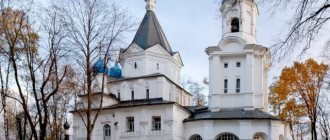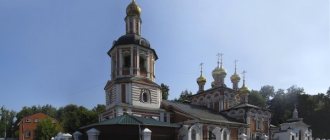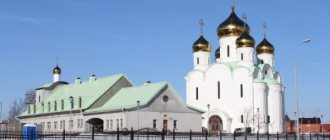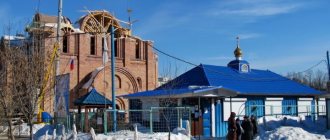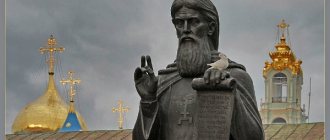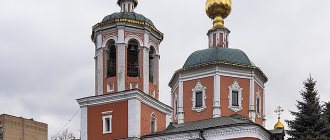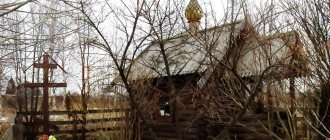The Krutitsky Patriarchal Compound is a living piece of old Moscow, but at the same time devoid of any pomp and splendor. There are no crowds of pilgrims and tourists here, and sometimes the silence is such that you will not find in cemeteries. Krutitsy is an ideal place for a tourist who has strayed from the group, for a Christian believer tired of more solemn churches and monasteries, for an artist or photographer in search of inspiration.
However, the external modesty of this place is not only cute, but also deceptive. In the seventeenth century, during the Polish occupation, the local Assumption Cathedral for a short time actually became the main Orthodox church of the city; it was there that the militia of Minin and Pozharsky prayed before the battle. In our time, the Compound began its stellar path in cinema; dozens of historical and adventure films were filmed here, including “Midshipmen, Forward!”, “Mikhailo Lomonosov”, “Secrets of Palace Revolutions”.
How to get there and where else to go nearby
Krutitskoye Podvorye is located in the Tagansky district. Coming out of the Proletarskaya metro station, you will plunge into the usual bustle of a residential area, with its shopping centers, bookmakers and eateries. The wide street, called 3rd Krutitsky Lane, is not suitable for walking. Go straight, then cross the Simonovsky Val underground passage, and soon the terrain will begin to change. A real forest windbreak will appear among residential courtyards, as in Izmailovsky Park or Bitsa, shops and cafes will disappear. You need the second left turn after the underground passage - Krutitskaya Street, leading to the Compound, is no less strange and fabulous than it itself.
At the very beginning of the street is the Water Museum. This is a cozy small museum dedicated to the history of water supply in Moscow. Admission is free, and there are guided tours for adults and children. For those who don’t get enough time in the Krutitsky Compound, a trip there will be a great addition. Among other attractions, there are two monasteries nearby - the Novospassky men's monastery (its bell tower is visible on the road from the metro) and the Pokrovsky women's monastery (popularly famous thanks to the relics of the Blessed Matrona of Moscow). And from the Krutitsky courtyard you can easily go out to Krasnokholmskaya embankment, admire the beautiful view, and then take a river bus at the Novospassky Most pier and ride along the Moscow River.
Krutitsky Patriarchal Metochion
Location of the old farmstead
The return of church order brought the ancient monument back to life, filled it with familiar content and opened up prospects for restoration. In 2021, the Moscow government adopted a plan for the restoration of the Resurrection Cross House Church. An important role is also played by the fact that the metochion is the coordination center of the Patriarchate for work with Orthodox youth.
Under the leadership of Archpriest Kirill Sladkov, rector of the Church of the Assumption of the Blessed Virgin Mary on Krutitsy, a Sunday school, a rehabilitation center for those suffering from alcoholism and drug addiction, and charitable and educational events are organized.
Krutitskaya street, house 13/1 - the official address of the Krutitsky courtyard in Moscow. How to get to it, you can find out in many ways (Mosgorspravka, the official website of the monument, map, navigator), but if preference is given to walking around the city, then you should take the metro to the Proletarskaya station, cross Simonovsky Val and exit into the first Krutitsky lane , which is a kind of courtyard of the old architectural ensemble.
The journey from the Taganskaya metro station is also short. Interest in this place is constantly growing, so you can join excursions that are organized to introduce visitors to the capital’s attractions.
History of the Krutitsky Compound
In ancient times, on the site of the monastery there was the village of Krutitsy. It was called that because of the hills that adorned the left bank of the Moscow River below the mouth of the Yauza. The appearance of the Krutitsy farmstead is due to the Tatar invasion.
In 1261, Alexander Nevsky founded an Orthodox diocese in the capital of the Golden Horde, Sarai-Batu, for Russians captured by the Tatar-Mogul captivity. The diocese was named Sarsk and Podonsk. In 1272, the Sarsk diocese built its courtyard in Krutitsy. In 1454, Bishop Vassian decided to move his residence to Krutitsy and began to be called the Bishop of Krutitsky, Sarsky and Podonsky. At first, all church buildings in Krutitsa were wooden. But already in 1516, the first stone church was founded - the Assumption Cathedral (later it was rebuilt into the metropolitan chambers). In 1589, the Krutitsa bishops received the status of metropolitans (the first of them was Metropolitan Gelasius).
One of the most striking pages in the history of the Krutitsky Compound dates back to the Time of Troubles. While the Assumption Cathedral of the Kremlin and other famous churches in the then city center were captured by the Poles, services for Muscovites were still held in the Assumption Cathedral of the Krutitsky Compound. In 1612, in the Krutitsky Assumption Cathedral, the militia of Minin and Pozharsky swore in front of the shrines to liberate Moscow from its enemies. In fact, in those years the temple acquired the status of the main cathedral in the eyes of the residents.
At the end of the seventeenth century, reconstruction took place in the Podvorye, the main buildings acquired a look close to the present one. By 1700, the Assumption Cathedral was rebuilt from red brick, in 1693 a beautiful gate tower (Krutitsky Teremok) appeared, and special passages were built between the cathedral and the Metropolitan Chambers (Resurrection and Assumption).
In the eighteenth century, difficult times came for Krutitsy. In 1764, the Sarsk and Podonsk diocese ceased to exist, and in 1785, the Krutitsa diocese. The property and archives of the church were transported to the Chudov Monastery in the Kremlin, and the territory of the courtyard was transferred to the military department. The Assumption Cathedral turned into a modest parish church for military personnel. Fortunately, no one began to destroy or rebuild the chambers and churches, but barracks and a guardhouse were built nearby.
In 1812, the Assumption Cathedral was seriously damaged by fire. Almost nothing remained of the temple, so the military even proposed dismantling it piece by piece and putting stables in its place. But the church authorities could not allow such disgrace, so in the coming years the cathedral was given “first aid” in the form of a wooden roof and new walls. It was only in 1833 that systematic reconstruction began, which lasted until 1868.
Soviet power reached the Krutitsky courtyard in 1924. The territory again completely passed into the hands of the military. In the 30s, the Church of the Resurrection of the Word was rebuilt into barracks, and a children's playground was built on the site of the cemetery. There is a version that the arrested Lavrentiy Beria was kept in the Krutitsky barracks.
After the war, luck smiled on the quiet cultural monument again: they decided to restore it, entrusting this task to the famous architect and restorer Pyotr Baranovsky, who saved more than one Moscow temple from demolition and destruction. The restoration lasted more than thirty years. Upon its completion, the farmstead finally received the status of a museum object. Since 1982, it became one of the branches of the Historical Museum, and in 1991, part of the objects was transferred to the church.
Decline and first restoration
With the abolition of the patriarchate in 1821, the abbots of the monastery were demoted in rank to bishops, and the metochion itself lost its unique position. The Trinity Fire of 1737 brought irreparable destruction, and a lack of funds delayed its reconstruction. As a result, some of the buildings were destroyed, the existing seminary (1744−1751) was transferred to the Intercession Monastery, and the burnt faces of the saints were whitened.
Under Catherine II in 1788, the Krutitsa diocese was finally abolished , church archives were transported to the Kremlin, and most of the buildings were transferred to the Military Department. The gendarme department did not find anything better than to set up a garrison guardhouse in the monastery chambers, where Alexander Ivanovich Herzen subsequently spent seven months before being exiled to Vyatka.
The courtyard was also damaged during the fire of 1812. The iconostasis was completely destroyed, the roof of the Assumption Cathedral burned out, and the lower Peter and Paul Church was so cynically desecrated by the French that it had to be reconsecrated in 1813. The interior decoration and ceilings of the Church of the Resurrection were lost, which was almost destroyed in the post-war years, and only the intervention of the future Emperor Alexander II in 1838 stopped this barbaric intention. He also ordered the restoration of destroyed buildings in Krutitsy.
The initial restoration was carried out according to the plan of Evgraf Tyurin, and the work was completed by Konstantin Ton (author of the Cathedral of Christ the Savior). The amount of work was significant, but the condition of the complex still remained extremely unsightly. By that time, the Krutitsky ensemble was already located almost in the city center, so in 1904 another restoration project was proposed, but due to funding problems, its consideration was postponed.
Krutitsky Compound in cinema
The undaunted antiquity and lush greenery of Krutitsa have been attracting directors since the late 70s. Two films each about Boris Godunov and Ivan the Terrible, separate episodes of the films “Young Russia” (1981), “Burn, Burn, My Star” (1969), “Mikhailo Lomonosov” (1986), “Midshipmen, Forward!” were shot here. (1987), “Ermak” (1996), “The Brothers Karamazov” (2009). The Krutitsy Compound managed to “visit” the Kremlin, the Uglich Palace, the Old Believer temple where Savva Morozov prayed, the cities of Kiev, Chisinau, Revel (the old name of Tallinn) and just a conventional Russian monastery.
Mostly, of course, films and TV series about Russian history were shot here. But this list somehow included “Brother-2” (one of the Krutitsa houses plays the role of the Matveevsky police department), “Daun Haus”, the serial melodrama “Give Me Resurrection” (2012), and the comedy “Scammers” (1990). Polish director Krzysztof Zanussi also visited the courtyard.
Krutitsky courtyard today
In a sense, Krutitsy can be called an open-air museum. Except for the Assumption Cathedral, all buildings are now closed to the public and can only be admired from the outside. But you won’t spend any money - except perhaps on pies in the stall at the entrance or on candles in the temple. Unlike the well-groomed museum grounds, here you can and should climb everywhere, go through dilapidated gates, walk on the grass, look into the windows of service premises, take photographs of everything and everywhere. We only advise you to wear comfortable shoes, because there is no asphalt in this historical corner - only uncomfortable cobblestones, dirt and tall grass.
What to see in the Krutitsky Compound?
Here are the main interesting objects at the Krutitsky Compound:
- Assumption Cathedral. Construction was completed in 1700. Services are regularly held in the temple, and a church shop is opened in the neighboring house.
- Metropolitan Chambers (Palace of Krutitsa Metropolitans) - built 1655-1670.
- Church of the Resurrection of the Word on Krutitsy (17th century).
- Krutitsky Teremok above the Holy Gates - 1693.
- Embankment Chambers (summer house of the metropolitans) – 1719.
what to see in the Krutitsky courtyard
But the main charm of Krutitsy is not in the famous temples and palaces, but in the small wooden houses of unknown purpose, in the ancient stone steps overgrown with moss, in the closed doors leading incomprehensibly to where with heavy locks, in the servants and workers hurrying about their business, who are here clearly more than tourists. It smells like a dacha, the Moscow region, to which this area belonged in the past centuries. The dew on the grass does not dry for a long time, and the burdocks have grown almost to human height. There is also a small cherry orchard here, which you should definitely visit in the spring.
Schedule of services
@arch1921
On Sundays and holidays, the All-Night Vigil begins at 17:00 the day before, and the Divine Liturgy begins at 09:00.
On Saturday, as well as on weekdays, services are held at 08:00. During Great Lent, the Liturgy of the Presanctified Gifts is held twice a week.
On Thursday at 17:00 an akathist is held in front of the Theodore Icon of the Mother of God.

